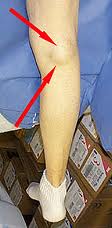[su_divider top=”no” style=”double” divider_color=”#952524″ link_color=”#952524″ size=”2″ margin=”10″]
What is Baker cyst or Popliteal Cyst? How to manage it? What are the precautions to be taken? What are the signs and symptoms? What is the cause of this disease? How to treat it? How can homeopathy help you? All of this answered, in this post and of course our doctors always there to help you. Just fill in your details in the form down below and we will answer all your questions for FREE!
[su_divider top=”no” style=”double” divider_color=”#952524″ link_color=”#952524″ size=”2″ margin=”10″]
[sc name=”query”]

What is baker cyst?
A baker cyst is a swelling caused by fluid from the knee joint protruding to the back of the knee.
The back of the knee is also called the popliteal area. Therefore, baker cyst is also known as Popliteal cyst. It happens when the excess of knee joint fluid is compressed by the weight of the body between the bones of the knee joint, which get trapped and separate from the joint to form the fluid-filled sac called a cyst. They may be soft and having minimal tenderness.
What are the symptoms of Baker’s cyst?
- Knee pain
- Tightness/stiffness behind the knee
- Inability to flex or extend the knee
- Swelling behind the knee.
What are the causes of Baker’s cyst?
The excess joint fluid (synovial fluid) bulges to the back of the knee to form Baker’s cyst.
- The most common type of arthritis associated with the popliteal cyst is osteoarthritis & also called degenerative arthritis.
- It can occur in children with juvenile arthritis of the knees.
- It can also result from cartilage tears (torn meniscus), rheumatoid arthritis, and other knee problems.
What happens if Baker’s cyst goes untreated?
Baker’s cyst isn’t usually dangerous but if left untreated occasionally they burst, and if that happens, synovial fluid can leak into the calf below, causing pain, swelling, and redness.
Can a Baker’s cyst cause nerve pain?
Yes, baker’s cyst can cause neuralgia due to compression of the tibial nerve and at times peroneal nerve can also be involved.
Can you exercise with Baker’s cyst?
Yes, exercise helps in decreasing the symptoms as it strengthens the muscles around the knees.
How to detect baker cyst?
Baker cysts can be diagnosed by:
- Physical examination
- Ultrasound
- MRI scan
- Arthrogram – Injection of contrast dye into the knee
What is the treatment for Baker’s cyst?
- Baker cyst may resolve with the aspiration of excess knee fluid.
- When cartilage tears or other internal knee problems are associated, physical therapy like hot and cold fomentation can be given
- Homeopathic remedies can help in reducing the pain and early recovery of baker’s cyst.
What is the homeopathic treatment for baker cyst?
- Benzoic acid
- Calcarea Flour
- Iodum
- Silicea
- Mercurius Solubis
What are the complications of baker cyst?
- Rupture of the cyst, leading to swelling in the ankle due to leakage of synovial fluid
- Infection
Complications of baker’s cyst occur after surgical interventions.
- As during surgery cyst excision during there can be damage to nerve or blood vessel
- Postoperative knee cyst excision includes infection, hematoma formation, and recurrence of the cyst.
For more information, you can visit WebMD and eMedicine.
Baker cyst
[su_divider divider_color=”#952524″ link_color=”#952524″ size=”2″ margin=”10″]
[sc name=”know-your-doctor”]
[sc name=”more-links-diseases”]

